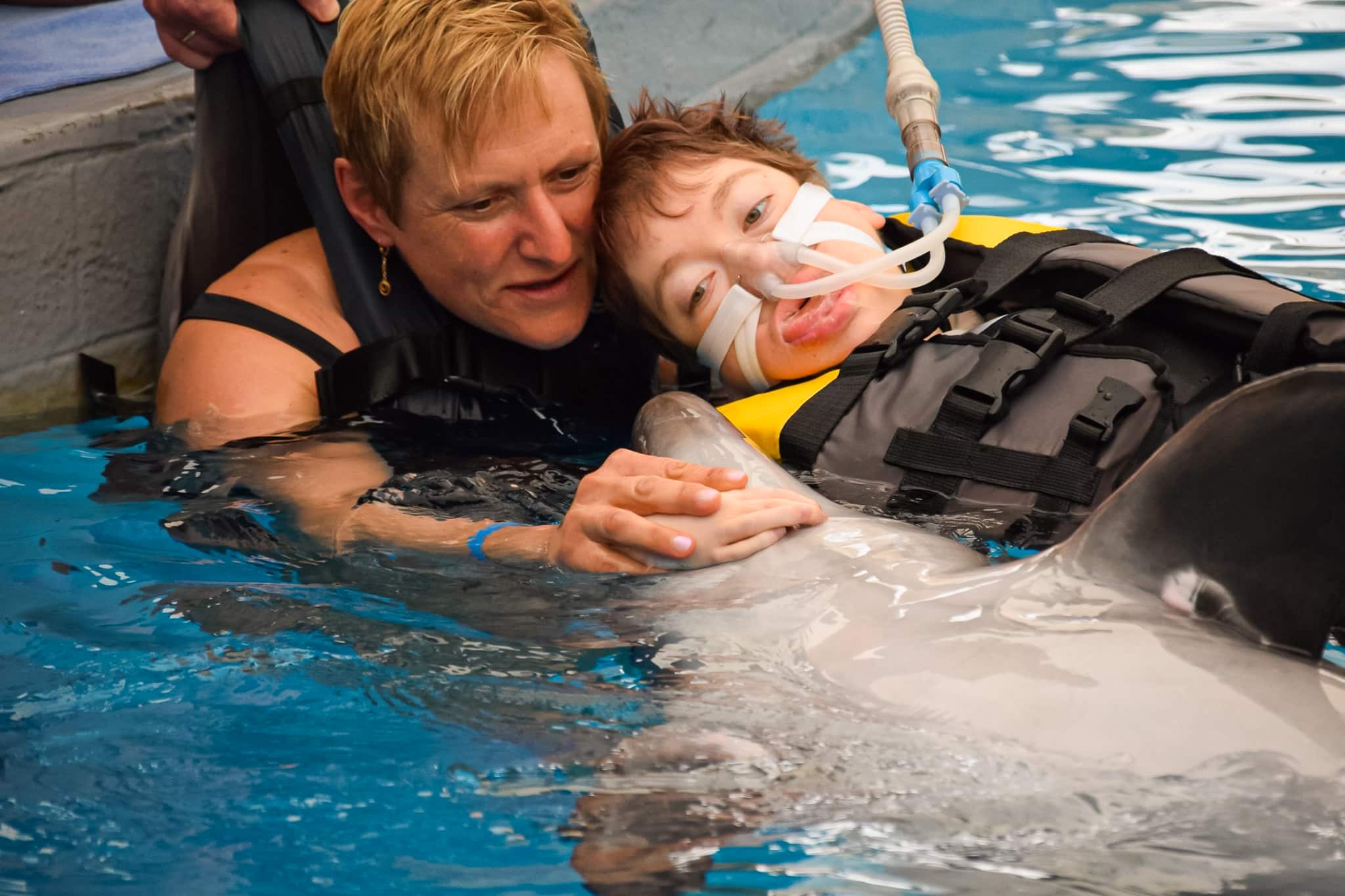Animal Assisted Therapy has been around since the 18th century; however, only recently have we started including dolphins into the healing and therapeutic process. Dolphins’ abilities and natures have proven to be instrumental in therapy in part because of their intelligence and “chameleon” like personalities. They can moderate behavior and interaction depending on who they interact with. This allows each patient to get the dolphin’s personal feedback as they progress through their healing journey. A movement of dolphin therapy began to grow in different ways to include dolphins in the healing process.


The scientific and historical foundation behind Dolphin Assisted Therapy (DAT) that leads to some of its successful findings and discovered benefits:
Thanks to John C Lilly in the 1950s, dolphins became a subject of science. John C. Lilly is a dolphin researcher and neuroscientist who made some of the first discoveries on dolphins’ psychological effects on humans in the 1950s. (Alpha-Therapy) Throughout his research career, he discovered that interactions with dolphins increase the sensibility, perception, and self-awareness of people involved. John Lilly is also known as the researcher who suggested that dolphins are as intelligent as humans, which he attributed to the fact that their brain’s volume is larger than that of humans. (Alpha-Therapy)
However, future studies determined they are biologically and anatomically unable to be as intelligent as humans. Although in several other studies conducted, they determined that dolphins are basically multilingually capable, quickly learn assignments of signals to certain objects and actions, distinguish and identify their body parts, have self-awareness, and learn new behavior very quickly. (Alpha-Therapy)
Additional studies have provided insight into effects from reducing anxieties to the promotion of social and linguistic development. Horace Dobbs, one of the pioneers of applied dolphin therapy in the 80’s, observed that dolphins could have positive effects on the state of mind. In addition to other researchers, over time, Dobbs was able to develop evidence of dolphins playing a significant role in reducing anxiety and depression. Dave Nathanson, an unarguably distinct pioneer in the application of dolphin therapy in the ’80s, not only questioned the effects of dolphins on language development with attention-deficit disorders but also discovered the basic concept of the Dolphin Human Therapy (DHT). (Alpha-Therapy)

Kohn & Oerter later discovered further positive influence, to include significant results in the following areas: cognition, language, self-employment, self-awareness, emotion, and motor skills. Furthermore, in the 90s, Ludmilla Lukina’s practice focused on involving dolphins as social partners and the complex interaction between the dolphin and the child, which catalyzed the child’s development processes.(Alpha-Therapy) In addition to this psychological effect, Lukina paid particular attention to possible neurological effects, determined to be caused by the dolphin’s SONAR. (Alpha-Therapy)
Lukina’s study revealed an improvement in enuresis, language disorders, pronunciation, phobias, fears, anxiety, restlessness, depression, sleep-cycle, appetite, independence, mood, social activity, motivation, well-being, and neurasthenia. (Alpha-Therapy)
“In 2005, Norbert Trompisch’s dolphin therapy study examined the quality and expression of the dolphin therapy changes with different disorders, including autism, cerebral palsy, down syndrome, and developmental delay. It was found that therapeutic effects depend not only on personal factors but also on the interference. It suggests that individuals with autism benefit with regards to their social skills, individuals with down syndrome and developmental delays benefit with regards to their linguistic field, and individuals with cerebral palsy benefit in their physical abilities. However, it was discovered that all individuals benefitted from an increase in self-confidence and a reduction in anxiety.” (Alpha-Therapy)
In 2000, Norbert Trompisch implemented the “Alpha-therapy” approach in Egypt. For the first time, dolphins took the front seat and played a bigger role than ever before by stimulating the environment in multiple activities throughout therapy sessions. The results were found to have “positive changes in the social-emotional behavior and emotional stability of children, positive change in the mother-child interaction, and was also found to be more effective than other animal-assisted therapies.” (Alpha-Therapy)

Patients who include dolphins in their therapy report more connection, reduced pain, and deeper healing with a better experience in their therapy. Norbert Trompisch defined Alpha Therapy as “a holistic form of dolphin therapy in which the stimulating effects of the dolphins are therapeutically implemented using scientifically proven therapy methods. This intensive therapy program can affect lasting improvements across a very broad field of application ranging from mild to severe disabilities and mental disorders.
As a family therapy, Alpha-therapy can strengthen resources and lead to new directions of constructive togetherness. It can contribute positively to every family, and not just those with an existing disability or illness.” (Alpha-therapy)

The scientific and historical foundation behind Dolphin Assisted Therapy (DAT) that leads to some of its successful findings and discovered benefits:
Thanks to John C Lilly in the 1950s, dolphins became a subject of science. John C. Lilly is a dolphin researcher and neuroscientist who made some of the first discoveries on dolphins’ psychological effects on humans in the 1950s. (Alpha-Therapy) Throughout his research career, he discovered that interactions with dolphins increase the sensibility, perception, and self-awareness of people involved. John Lilly is also known as the researcher who suggested that dolphins are as intelligent as humans, which he attributed to the fact that their brain’s volume is larger than that of humans. (Alpha-Therapy)
However, future studies determined they are biologically and anatomically unable to be as intelligent as humans. Although in several other studies conducted, they determined that dolphins are basically multilingually capable, quickly learn assignments of signals to certain objects and actions, distinguish and identify their body parts, have self-awareness, and learn new behavior very quickly. (Alpha-Therapy)
Additional studies have provided insight into effects from reducing anxieties to the promotion of social and linguistic development. Horace Dobbs, one of the pioneers of applied dolphin therapy in the 80’s, observed that dolphins could have positive effects on the state of mind. In addition to other researchers, over time, Dobbs was able to develop evidence of dolphins playing a significant role in reducing anxiety and depression. Dave Nathanson, an unarguably distinct pioneer in the application of dolphin therapy in the ’80s, not only questioned the effects of dolphins on language development with attention-deficit disorders but also discovered the basic concept of the Dolphin Human Therapy (DHT). (Alpha-Therapy)
Kohn & Oerter later discovered further positive influence, to include significant results in the following areas: cognition, language, self-employment, self-awareness, emotion, and motor skills. Furthermore, in the 90s, Ludmilla Lukina’s practice focused on involving dolphins as social partners and the complex interaction between the dolphin and the child, which catalyzed the child’s development processes.(Alpha-Therapy) In addition to this psychological effect, Lukina paid particular attention to possible neurological effects, determined to be caused by the dolphin’s SONAR. (Alpha-Therapy)
Lukina’s study revealed an improvement in enuresis, language disorders, pronunciation, phobias, fears, anxiety, restlessness, depression, sleep-cycle, appetite, independence, mood, social activity, motivation, well-being, and neurasthenia. (Alpha-Therapy)
“In 2005, Norbert Trompisch’s dolphin therapy study examined the quality and expression of the dolphin therapy changes with different disorders, including autism, cerebral palsy, down syndrome, and developmental delay. It was found that therapeutic effects depend not only on personal factors but also on the interference. It suggests that individuals with autism benefit with regards to their social skills, individuals with down syndrome and developmental delays benefit with regards to their linguistic field, and individuals with cerebral palsy benefit in their physical abilities. However, it was discovered that all individuals benefitted from an increase in self-confidence and a reduction in anxiety.” (Alpha-Therapy)
In 2000, Norbert Trompisch implemented the “Alpha-therapy” approach in Egypt. For the first time, dolphins took the front seat and played a bigger role than ever before by stimulating the environment in multiple activities throughout therapy sessions. The results were found to have “positive changes in the social-emotional behavior and emotional stability of children, positive change in the mother-child interaction, and was also found to be more effective than other animal-assisted therapies.” (Alpha-Therapy)
Patients who include dolphins in their therapy report more connection, reduced pain, and deeper healing with a better experience in their therapy. Norbert Trompisch defined Alpha Therapy as “a holistic form of dolphin therapy in which the stimulating effects of the dolphins are therapeutically implemented using scientifically proven therapy methods. This intensive therapy program can affect lasting improvements across a very broad field of application ranging from mild to severe disabilities and mental disorders.
As a family therapy, Alpha-therapy can strengthen resources and lead to new directions of constructive togetherness. It can contribute positively to every family, and not just those with an existing disability or illness.” (Alpha-therapy)